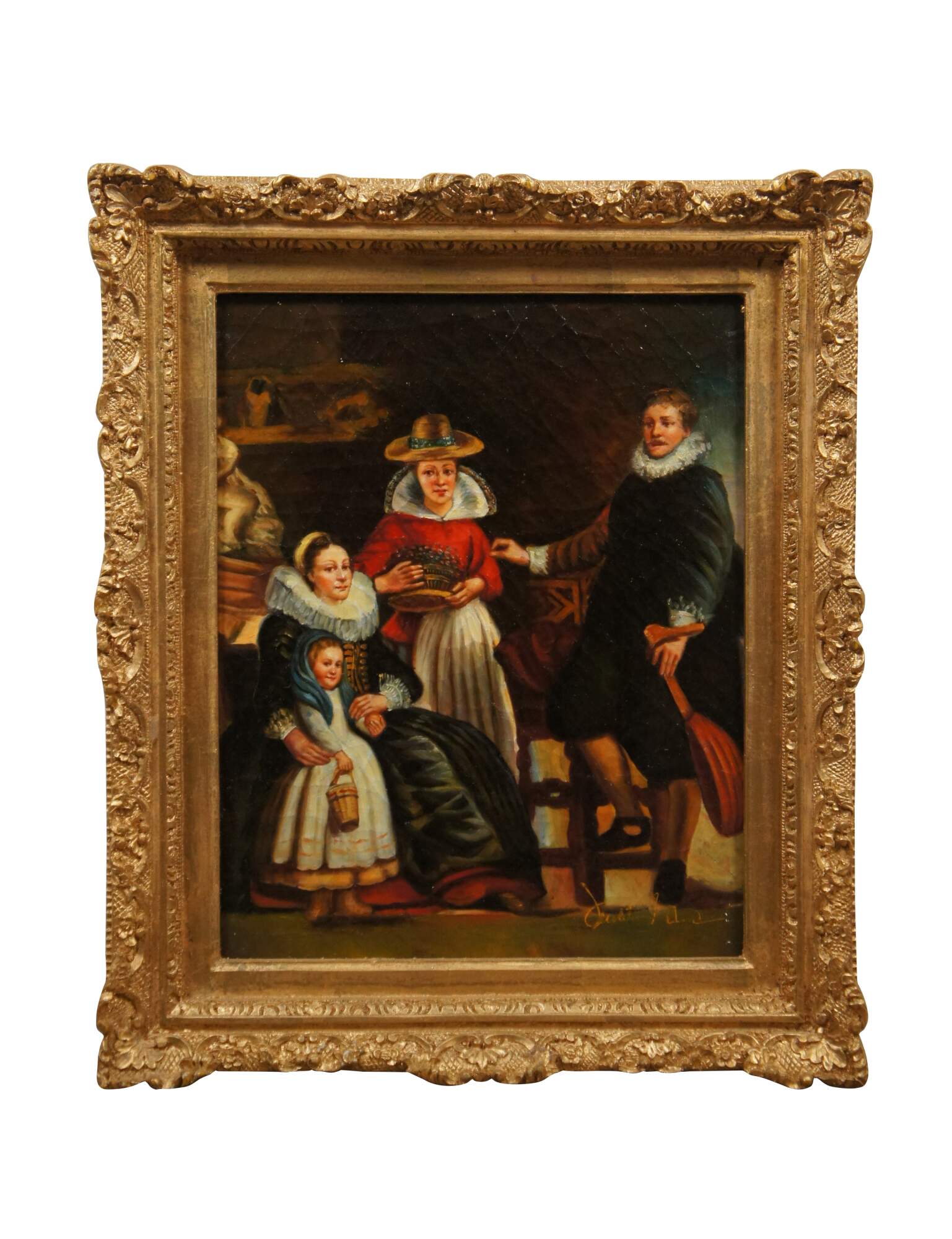
Shipping:
Free Shipping Included
Delivery:
Estimated 2-15 Business Days
Payments:
Credit Card, Check, Cash, PayPal, Apple Pay, Venmo
Returns:
30 Days 100% Money Back Guarantee, Buyer Pays Return Shipping
Description
Late 20th century oil painting on linen after "The Artist's Family" by Jacob Jordaens, originally painted circa 1621-1622 (currently house at the Museo del Prado). Depicts Jordaens standing with his wife, daughter, and a servant. Beveled frame with resin molded foliate / scalloped designs and a gold finish.
"This attractive group portrait, one of the most interesting of the 17th-century Dutch school on account of its bourgeois spirit with aristocratic leanings, is an extraordinary skilful depiction of the artist´s close family. Jordaens portrays himself with his wife Catharina van Noort and their first child Elizabeth, born on 26 June 1617, whose age allows us to date the work approximately. Catharina sits sturdily on an armchair; she is easily recognisable for her slightly almond-shaped eyes, prominent nose and fleshy, slightly drooping lower lip. Their daughter -dressed in popular style in accordance with her age, with a coral necklace from which hangs a cross and a basket of flowers in her right hand- is charmingly depicted, with an appealingly childlike expression; indeed, she sat for her multifaceted father on various occasions. Jordaens is personified by a dashing man standing upright, with his right hand and foot leaning on another armchair, the former on the back and the latter on the lower crosspiece, while his left hand holds a lute. It is not known whether he played musical instruments, though it would not have been unusual in a man so devoted to the arts and linked to a cultivated society. However, this object may also be a symbol of family harmony. The couple are elegantly dressed in black, not without a certain amount of ostentation, and display spectacular white ruffs, the wife´s larger and Jordaens´ more discreet. They both sport lace cuffs and Catharina´s dress has an embroidered bodice. She wears a small turban in the form of a bonnet, an elaborate jewel in her hair and earrings in her ears. Apart from their little daughter, the couple is accompanied by another woman, probably a servant to judge by her attire and position in the centre of the composition behind her master and mistress, set back from the foreground. Her clothing, richer in colour, contrasts with the sober distinction of theirs. She holds a basket of grapes, her head is framed by a high lace collar and she wears a high-crowned hat. This distinctive group is surrounded by a garden in which a few features stand out, though on the whole the setting is subordinate to the overall effect, without any predominant details. This has led art historians to believe that the painting belongs to a long tradition dating back to the medieval period of including the protagonists in a typical jardin d´amour. The intertwining grapevines behind the couple are related to the idea of the indissolubility of the matrimonial link established by man and woman. A fountain in the form of Cupid mounted on a dolphin can be seen in the upper left corner. This was a feature of the gardens of love and Cupid, the son of Venus, the goddess who was born of sea foam, is identified with Love itself. The parrot behind them, a motif found in a few works by Rubens and by Jordaens himself, may have various meanings, though here it is identified with the virtue of marital faithfulness. The fruit that the little Elizabeth holds in her left hand is also a symbol of love, just as the flowers in her basket represent innocence and purity. Lastly, the dog peering out from behind the artist´s legs, the faithful animal par excellence, alludes to faithfulness as the basis of the close union that all spouses should preserve throughout their existence (Text drawn from Luna, J. J.: From Titian to Goya. Great Masters of the Museo del Prado, National Art Museum of China-Shanghai Museum, 2007, p. 371)." (Source: Museo del Prado)
"Jacob (aka Jacques) Jordaens was born in Antwerp, Belgium in 1593. In 1607 he entered the studio of Adam van Noort, whose daughter he later married. In 1615 he became a member of the Guild of Saint Luke, and in 1621, its President. He painted only a few portraits, among them his well-known self-portraits. For the most part he worked on large and ambitious decorative projects, employing a staff of students and assistants. Born in another age or in another country, Jordaens might have been considered a great painter. But Vermeer, Rembrandt, Rubens and Van Dyck were all famous in the Low Countries at the same time as Jordaens and so he took a back seat to them. Painters of the time helped each other out on the monumental canvases they painted and some scholars believe that approximately thirty paintings and seventy drawings attributed to Rubens were really Jordaen's work. He died in 1678, the same day as his daughter. " (Source: askART)
Condition
Good Overall - Gentle wear; crazing to surface
Dimensions
21.5" x 2.5" x 25.5" / Sans Frame - 15" x 19" (Width x Depth x Height)